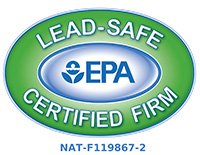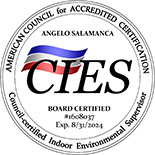What is Asbestos?

Asbestos is a naturally occurring mineral fiber that has been used in more than 3,000 different construction materials and manufactured products. It is commonly found in heating system insulation, decorative spray-on ceiling treatments, vinyl flooring, cement shake siding, and a variety of additional materials. Some asbestos-containing materials were still being installed into the late 1980's.
The asbestos content of different materials varies according to the product and how it is used. Among the materials with higher concentrations of asbestos are insulation products on heating systems and the backing of sheet vinyl flooring. It may be dangerous for your health if you need to tamper with asbestos-containing materials for remodeling or other repairs.
Airborne asbestos is a serious health hazard and can cause cancer or fatality.
Breathing in Asbestos Fibers Can Kill You
When disturbed, asbestos breaks down into fibers up to 1,200 times thinner than a human hair. When released into the air, asbestos fibers cannot be seen and can quickly circulate through your home. When inhaled, these fibers become trapped in lung tissues. Medical research tells us that up to 30 years after inhalation, asbestos fibers can cause lung cancer and Mesothelioma, a terminal cancer of the tissue that lines the chest cavity. This illness is directly connected to Asbestos exposure.
There is no known level of asbestos exposure that is safe. Medical, environmental health, and regulatory organizations stress the need to protect health by minimizing exposure to airborne asbestos fibers, particularly at elevated levels. Elevated levels can result from uncontrolled removals of asbestos-containing materials during a remodeling or renovation projects.
How to Check for Asbestos on Your Property
Look in the following places:
Spray-On Popcorn Ceilings
This heavily textured ceiling application was common from the mid-1960s through the early 1980s. It is extremely fragile, so it releases asbestos fibers quite readily when disturbed. It is important to always wear proper equipment as pictured below.

Vinyl Flooring
Sheet vinyl and vinyl tiles may contain asbestos. Sheet vinyl can be dangerous to remove because it may be backed with felt fabric that contains high concentrations of asbestos. Fibers may be readily released into the air if this backing is disturbed while it is dry. Tiles are generally safer because asbestos fibers are bound up inside the tiles in a petroleum base.

Exterior Siding
Cement asbestos-board siding, as seen below, is a very dense, brittle product used primarily in the 1940s, 1950s, and into the 1960s.

Heating Systems
Many properties heating appliances and heating systems contain asbestos insulation or gasket materials. It's common to find it as insulation on old furnaces and boilers, heating ducts, and hot water pipes or in insulating board materials installed around heating ventilation and air conditioning systems.

Other Possibilities
Additional materials in the home that may contain asbestos include ― acoustical ceiling tiles, plaster, stucco, knob-and-tube wire insulation, and artificial fireplace logs and ashes.
Have an Asbestos Survey Completed and Lab Test
If you are unsure of what to inspect for or do not have the proper safety equipment, you can hire an asbestos consultant company to conduct an Asbestos Survey. During their survey and inspection, they will be able to identify and assess areas for any possible asbestos fibers.
When in Doubt, Assume There is Asbestos
If you decide not to check for asbestos in a suspected material, you should assume it contains asbestos and takes all the necessary precautions to avoid harm to you or your family. We HIGHLY ENCOURAGE you to check any suspected material.
Options for Dealing with Asbestos in Your Home
Repair
Sometimes, asbestos can be repaired rather than removed. This is basically a process of securely resealing asbestos in its location. For example, a few inches of torn, loose, or frayed asbestos tape wrap on heating ducts can be repaired with duct tape. Damaged hot water pipe insulation can be covered with a specially designed fabric available at safety equipment stores.
Encapsulation
Similarly, some asbestos applications that are in good condition can be encapsulated to stabilize them and reduce the likelihood of asbestos fibers releasing into the air. Encapsulation is the best option when dealing with insulation on heating systems. There are two types of encapsulates. Penetrating encapsulates are products that seep into asbestos-containing materials and bond with asbestos fibers securing them in place. They have little impact on the outward appearance of treated materials. Bridging encapsulates are products, such as paint, with asbestos-containing materials with a more durable surface. They are most commonly used to encapsulate popcorn ceilings and furnace and heating insulation.
Be aware, however, that while encapsulation may seem like an attractive option, especially for furnace ducts or popcorn ceilings, there may be less obvious costs and risks involved. For example, painting to encapsulate may make a future removal much more difficult and expensive. Also, popcorn applications that become too heavy with added encapsulated product, or through water damage, may fall off the ceiling in clumps, possibly releasing asbestos fibers.
In cases involving extensive asbestos damage or disturbance, removal may be the more appropriate option.
Remove It
If you decide to have asbestos removed, we strongly recommend you hire Fundisa Restoration, a state-certified asbestos abatement contractor. We are experts and have access to trained workers and specialized removal equipment not available to do-it-yourself property owners, thereby ensuring asbestos is effectively and safely removed.
Before beginning a removal project an asbestos notification shall be submitted to the Florida Asbestos NESHAP's District or Local Office with the appropriate fee, then the agency will review and approve the notification to legally remove asbestos and dispose of it at specified asbestos disposal sites.
For additional information or direction, you can call Fundisa Restoration with your questions or to schedule asbestos removal at (844) 386-3472.








